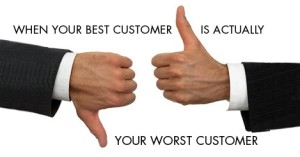You need to know your talents – and lack of them.
You have to know your stuff if you want to succeed. But being technically competent in the core part of your business is not the be-all-and-end-all. There are other things even more important if you want to build a successful, profitable enterprise. Your experience and training does not always reward you for the things that are useful in the real business world. Sometimes it even encourages behavior that will be detrimental to your future business.
People use the environment to make value judgments about the character and talents of the people in that environment. For good or bad, we do use the personal appearance of others to make judgments about their character and value. Do not expect your customers to value the same things that you and your peers value. The way you appear to do something is often more important than what you do.
Concerning what you do:
· Logic – what people think is powerful
· Emotion – what people feel is far more powerful still!!
· People don’t always value technical excellence…sometimes they just tolerate it.
Introducing the CNE’s
Customers judge your expertise in areas they do not understand by your expertise in areas which they do. When you pay attention to detail in the very visible, non-technical part of your business, clients will tend to judge your core product or service as also having the same level of quality control. So these little things that are quite inessential for doing your job (and which don’t impress your peers at all) nevertheless seem to play a great part in persuading customers that you and your people are good at what you do.
So CNE’s are not really non-essentials at all. In fact they are highly critical to any business.
That said…because they seem to be so unimportant it is often hard to find the time to systematize them…it’s far easier to justify the time to develop systems so that the main areas of your business are taken care of predictably.
Super CNE’s
· They persuade uninvolved third parties to say nice things about your business.
· Word of mouth is a powerful, speedy and cost effective way of marketing your business.
· People value relationships above everything else.
· I need to understand the power of the CNE’s to effortlessly do ‘good’ in my business.
How To Create CNE’s
Step 1: Choose an area that will convince customers that you’re good at your core business.
e.g. an electrician who creates a system for cleaning up after himself so that the work area is absolutely spotless, i.e.
• A detailed description of the method
• A checklist
• A system for reporting
• A small clean-up box with cloths, cleaning fluids, small vacuum, rubber gloves etc
- e.g. a dentist who has immaculately clean walls, floors and carpets etc doesn’t have to worry about posting impersonal notices about how they sterilize the instruments.
- e.g. a dental laboratory that presents caps with care to a dentist will have find that the dentists are far less likely to regard the quality of the cap suspiciously.
- e.g. a bank that sends out a statement that’s plain, easy to read and human is far more likely to keep customers happy than one that looks like it’s from an automatic blood-scanning machine & which is full of cold, impersonal words
No matter how good you say you are. It often takes a well-designed CNE to convince people that what you say is true.
Step 2: Make sure everyone in your work team understands the power of the CNE.
The way to persuade people to be vigilant and tireless in their creation & maintenance of CNE’s is to educate them to the real importance of the seemingly non-essentials. You must show your people that it’s in their best interests to impress your customers…and then that CNE’s really WOW customers.
Step 3: Make a system to ensure that the task is always completed flawlessly.
Design simple, routine systems to do your CNE’s the same way every time – without a lot of effort or brainpower (which would be silly).
Systems = consistency
It takes some effort to set them up but once perfected they’ll take little effort or thought. The outcome is…simple systems that make a large impact on the customers and, after initial development, require relatively little effort.
e.g. Washrooms in a supermarket that are always immaculate
• Manual for the cleaners
• Training for the cleaners
• Card showing when due, cleaned
• Notices urging customers to report unsatisfactory state
• Periodic supervisor checks
• Weekly check of all cards
You & your team will be rewarded each time a CNE impresses a customer…and once the team realise the importance…your standards will rise.
Six Insights Into CNE’s
Well constructed CNE’s take on a life of their own – complex tasks will happen automatically. They work behind the scenes & s sometimes it’s hard to spot their immediate benefits.
Insight 1: CNE’s will work with your team
Insight 2: CNE’s will work with your suppliers. Concentrate on the little things in business & the big things will look after themselves.
Insight 3: CNE’s are very efficient. They offer a far greater return on your investment of time & effort than most other things in your business. Work today while you have the time & energy in order to make things easier for you in the future when you don’t. Make sure that any effort you expend has an effect beyond the effort involved.
Insight 4: CNE’s bring out the best in people. A good CNE has a positive effect on everyone.
Insight 5: You can create situations where other people’s CNE’s work for you.
e.g. Paddi’s gardener goes the extra mile to keep his gardens immaculate because he’s allowed him to place a plaque advertising his business on the garden wall, i.e. it’s in his best interests to keep Paddi’s garden looking amazing.
Insight 6: CNE’s need celebrations.
e.g. including the building cleaner in the bonus scheme & displaying her photo along with he other team members.
The Birth Of The Super CNE’s
How to systematize the process of delighting your customers.
Everyone likes to spin a good ditty – so why not create one for your customers to tell about your business?
e.g. Tea Set & Tea Ceremony vs. the X-Ray Machine.
No-one ever told a story about the excellent X-Ray machine. Over the years the Tea Sets have returned many times the investment but the X-Ray machine has barely broken even.
e.g. The 4 Door, V8 Cappuccino Machine.
C
NE’s versus Super CNE’s
CNE’s
• are the little household tasks that give people reasons to believe in your business, particularly the parts they don’t understand.
• In the background somewhat.
• Important but not exciting.
• Stop you getting bad press.
• Show you’re competent.
Super- CNE’s
• Are CNE’s taken to a sensational degree so that everyone remembers and talks about them.
• Get you good press.
• Provide the WOW that gives people a good ditty to spin.
• Provide the dazzle.
More About Super-CNE’s
What sets one business apart from another is often more to do with a product’s presentation than its actual quality. Super-CNE’s get you talked about = Lead Generation.
CNE’s get you the customer = Conversion Rate.
Some CNE’s will also increase Number Of Transactions, Average $$ Sale & increase your Margins.
Understand The Dialogue Between Customers.
A – Tells Super-CNE .
B – Yeah but is he good at his job?
A – Tells CNE stories which have convinced them that you are.
Super- CNE’s Are A PR Boon
How To Create Super-CNE’s
Step 1: Pick something you’ll enjoy.
Step 2: Choose something distant (but not too distant) from the core of your business.
Step 3: Build on CNE’s that are extremely visible.
Step 4: Pick areas of customer concerns to.
Step 5: Take your Super-CNE’s to the extreme.
Step 6: Make sure your Super-CNE’s appear difficult – but really aren’t.
Come back and let me know how you did!





